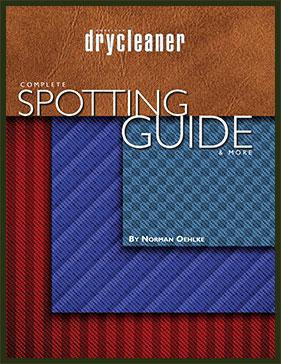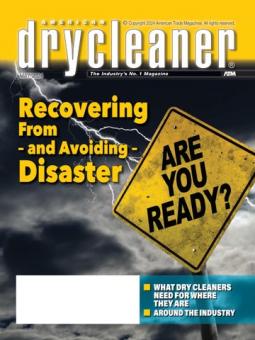Recovering From — and Avoiding — Disaster (Conclusion)

CHICAGO — While it’s impossible to completely delete risk from the equation of running a drycleaning business, it’s important to eliminate threats under your control, and have plans in place in case the worst does happen.
In Part 1 of this series, we examined different plans needed for different types of disasters, and the need to make sure the company’s insurance coverage is adequate and appropriate. In Part 2, we looked at the elements that all good disaster plans need to have. Today, we’ll conclude by exploring ways dry cleaners can keep operating during recovery, as well as ways to avoid disaster in the first place.
Wayne Wudyka, CEO of The Huntington Company, which includes businesses such as Huntington Cleaners, Wesch Cleaners and the Certified Restoration Drycleaning Network (CRDN) had a fire in one of his plants in 1999 that led to a roof collapse. Having a backup cleaner in place allowed him to keep his customers during the rebuilding process.
“We put a trailer on the property as a temporary call office,” he says. “We put a sign on it and had customers take their goods in and out while we basically wholesaled our work. This way, we kept our customers coming back. If a retail customer has to go somewhere else, they get a new pattern and wind up staying there.”
Leasing a plant from a competitor during their downtime can be a lifeline in this type of situation.
“Talk to the guy down the street and say, ‘Look, I’ll run your plant from 2 in the afternoon until midnight,’” Wudyka says. “You work out rent, work out a utility split, and now you’re keeping your employees and the other guy is renting his plant on his downtime.”
The extra rent and utility costs associated with a plan like this should be covered by insurance, Wudyka says. “When you have a claim, your business interruption insurance should kick in if you’ve got proper coverage.”
Again, having these discussions with competitors before disaster strikes is key to maintaining operations.
“It’s important to have a relationship with a vendor who can support you, and vice versa if they have an issue,” Wudyka says. “It can be profitable for them, too, because they’re going to offset their expenses as you use their idle plant time.”
While weather-related catastrophes are difficult to protect against — no amount of planning can deflect a tornado — owners and managers can take steps to lessen the chance of preventable disasters.
“Have normal maintenance procedures in your plant,” Wudyka says. “There are the obvious things, like dryer vents needing to be cleaned out daily. On/off switches on your irons and presses need to be checked. You leave an iron on sitting in a cradle overnight, that’s a problem. This happened in one of my plants. The presser left an iron on, and it overheated and caused a fire. Fortunately, it just burned itself off, but that could have been a major catastrophe.”
Wudyka suggests developing checklists that make standard preventative maintenance easier to follow: “A lot of times your issues are going to be just a lack of maintenance.”
Overloaded electrical service panels can also be a source of problems.
“If you add a steam tunnel or add a couple of washers and you don’t upgrade your panel, you can spark your panel up,” Wudyka warns. “A lot of cleaners will put a new washer or dryer in and just hope. Don’t assume anything.”
Lint buildup inside the building, he adds, can also be a fire flashpoint.
“I’ve seen a lot of fires happen as a result of lint on rafters and suspended light fixtures,” he says. “Lint builds up over time, and boom, a fire can just take off immediately. We have circulating fans in our plant that go on every night for about two hours. They are turbo fans on a 360-degree rotating head and basically knock down the dust. Lint is just very dry cloth. Put that on top of an 8-foot fluorescent strip that’s not sealed entirely, and you’ll have something that can easily arc.”
For cleaners who have vans, there’s a simple step that can save a building, and potentially lives, in the event of a fire.
“If you store vehicles inside your building,” Wudyka says, “leave the keys in the van. If you have a fire, the fire department will need to get the van out of there — if not, now you’ve got a fuel fire. They can’t be finding keys when it’s mayhem. That can also negate your coverage. If you don’t take these precautions and a claim happens, you could be declined.”
Kermit Engh, owner of Fashion Cleaners in Omaha, Nebraska, and managing partner of the consulting firm Methods for Management (MfM), believes disaster plans should be living documents because as your business evolves, so should your recovery strategy.
“I would suggest (reviewing) at a minimum once a year, because over a year’s period of time, things do change,” he says. “Your management structure may change, your market may change, and you need to stay on top of it. Don’t be in a position where you pull that plan off the shelf and it’s got an inch of dust on top of it because you haven’t looked at it. I would at least have the owner in the management team look at it, even if it’s just a 15-minute review, every six months.”
Wudyka agrees with this timeline.
“Once a year, at least,” he says. “Reconstruction is a lot more expensive now than it’s ever been — I don’t care what you’re building. So annually, at a minimum, you should sit down with your agent, go through your policy and shop it. Get educated on what’s covered and what isn’t, especially in today’s market.”
For Part 1 of this series, click HERE. For Part 2, click HERE.

TCATA Names Mack Magnus as New President

Recovering From — and Avoiding — Disaster (Part 2)

Royal Basket Trucks Named as a ‘National Top Workplace’

Recovering From — and Avoiding — Disaster (Part 1)

Report: Small-Business Job Openings Fall to Pre-Pandemic Levels

Getting on the Same Page with Employee Handbooks (Conclusion)

Zengeler Elected Chairman of Round Table of Launderers and Dry Cleaners

Getting on the Same Page with Employee Handbooks (Part 2)

Ohio Martinizing Cleaners Franchise Changes Ownership

Getting on the Same Page with Employee Handbooks (Part 1)
Podcasts for You
Boiler Sizing and Selection for Dry Cleaners

Learn practical tips on how to choose the right boiler capacity for your drycleaning operation from Mike Leeming, national sales manager with Parker Boiler Company.
Pleasantly Surprising Customers

Kyle Matthews of Detroit’s Janet Davis Cleaners offers ideas and outlooks for boosting the customer experience in your store, making you the only cleaner your clients consider.
Buying Out the Competition

When dry cleaners want to expand, they can either open new stores or buy out competition looking to get out of the business. We explore this topic with Gary Glover of Puritan Cleaners and Arthur C. Anton, Jr. of Anton's Cleaners.
From the Research Center
The Complete Spotting Guide & More

Attracting Customers & Increasing Profits—Drycleaning Marketing 101

How to Profit by Going Green: Simple Strategies That Are Friendly to The Earth & The Bottom Line

Latest Digital Editions
Digital EditionAmerican DrycleanerMay 2024

- Recovering From - and Avoiding - Disaster
- What Dry Cleaners Need for Where They Are
- Around the Industry

